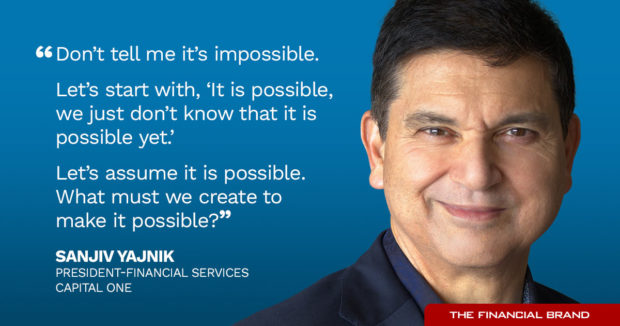Bankers have grown used to dealing with very large numbers. But how many even know how large a “quattuordecillion” is, let alone have dealt in such figures?
Capital One’s Sanjiv Yajnik has. He matter-of-factly notes in a conversation that term is the numeral “1” followed by 15 sets of three zeros. And he can readily explain what it’s got to do with banking — specifically, auto lending.
Yajnik, president-financial services, has been with Capital One for over 25 years, nearly from its beginning, the last 16 as head of the company’s auto finance operation based in Plano, Texas. But that hardly does justice to his time there. How many top auto lenders have been issued 18 U.S. patents, with more pending, during their time in banking?

Accelerate Time-to-Market with Rapid Implementation
Create a sustainable competitive advantage with faster time to market by drastically reducing implementation time.
Read More about Accelerate Time-to-Market with Rapid Implementation

Banking Transformed Podcast with Jim Marous
Listen to the brightest minds in the banking and business world and get ready to embrace change, take risks and disrupt yourself and your organization.
200 Quattuordecillion Reasons Auto Lending Needed Shaking Up
Yajnik is an engineer by training, not a banker and he was part of the cadre that formed the initial nucleus of Capital One — math and science types who had somehow stumbled into banking. He reports directly to Richard Fairbank, CEO and chairman. But his early years in India, were spent designing portions of huge commercial ships and on occasion operating on them as an engineer. He’s worked in mechanical, pneumatic, and hydraulic technologies and in time shifted to the digital world and brought that experience to banking.
“It’s really fun to build things,” says Yajnik. “I’ve done that all of my life.”
Yet initially he scratched his head over the challenge of modernizing auto finance. So many factors went into auto credit decisions and the pricing of approved deals. Affordability goes beyond the sticker to include aftermarket add-ons, warranties, service packages, insurance coverage and more. Overlay that with data about all the potential makes and models a consumer can buy, new or used, and developments in the repo market, and you’ve got a huge amount of information.

In fact, what you’ve got is 200 quattuordecillion potential combinations, says Yajnik.
“That’s a lot to consider for one customer,” says Yajnik.
Approvals, rate setting and more could take as long as a day, sometimes longer, using traditional methods. He thought technology could shortcut that process and give consumers a better idea of where they stood before they set foot on a dealer lot. Yajnik and his team began a process of crazed creativity. This was the beginning of Capital One Auto Navigator, which debuted in 2015.
Read more: Real-world Lessons for GenAI in Banking, According to Google
Weekends at the Whiteboard: Building Capital One Auto Navigator
Today, Auto Navigator is a highly rated mobile app that enables consumers to pick models, tinker with features, come up with pricing and payments, and walk into a dealership with a pre-approved financing offer. In 2023, a variation called Capital One Navigator Platform debuted, with additional features to make it a tool for auto dealers. Yajnik’s latest patent pushes the technology further, this time creating software that can price deals among multiple lenders as part of the process, in about a second.
Prior to 2015, that wasn’t even on the cards. Yajnik says tech development then consisted of assembling functionalities that others had already devised, rather than inventing.
“But starting in 2007, into 2011-2013, all of technology changed,” says Yajnik. “Hardware changed, software changed, chips changed, and cloud technology came on with major force. Mobile technology allowed us to do things more lightly.” Even applied programming interfaces (APIs) — which have made much of banking’s tech revolution possible — evolved from an older form called “SOAP” (Simple Object Access Protocol) to “REST” (Representational State Transfer), considered more flexible.
The bottom line was that Capital One and other financial services company found themselves in the age of the builder.
“Now you could build things that would have cost $100 million for $10 million,” says Yajnik. “And something that you could have built in seven or eight years with specialists could be built in six months with a group of tech generalists.”
All that remained was the work. A lot of work.
Yajnik says his guidance to his tech teams — and himself — ran as follows: “Don’t tell me it’s impossible. Let’s start with, ‘It is possible, we just don’t know that it is possible yet.’ Let’s assume it is possible. What must we create to make it possible?”
Starting with customers and how the bank wants to serve them lies behind the creativity that produced the company’s patents, says Yajnik.
Then followed a period of frenetic activity. “A whole bunch of us got together for this challenge. It became one of the most exciting times of our lives. We were literally running in to the office on weekends with an idea that had suddenly come to us, putting things down on the white boards,” says Yajnik.
New ideas could be spurred by a casual remark of a family member at the breakfast table or a side reference in an article. For some aspects of the project, teams were put into competition with each other.
Unlike the movies, there was no one “eureka” moment. As development progressed, the team found that new, unexpected challenges had to be solved before the next stage could be reached. “You look for another way to get the task done,” says Yajnik. “It’s not a linear process.”
Indeed, this is how many innovations — and patents — get produced at Capital One.
“I warn the people working on these jobs that it’s going to be an intense period, not a 9-5 thing. They have to opt in. But later on, they always say, ‘This is the most fun I’ve ever had in my life’,” says Yajnik.
Read more: Some Top Fintechs Value This Function as Much as They Do Innovators and Engineers

Dealing with Dead Ends … And ‘Worse’
The hackneyed meme of fintech’s early days —about running around and breaking things — is a luxury banks could never afford. But Yajnik says he has not seen this as a handicap.
“Innovating with the regulators watching really helps us in the long run, because what we build will be built to last,” he says. “It’s not going to be some quick thing that could start breaking down anytime. It’s not brittle.”
Yajnik believes financial technology innovation should arise from one of two possible sources. The first is the innovator’s insight into problems consumers have with the status quo, and finding a tech solution to it. The other is seeing new tech and realizing that it’s got to be the solution to something. Yajnik says this thinking runs like this: “I have a hammer, where is the nail? And how can I make my hammer better to hit different nails?”
Not every effort is a success. Sometimes an effort starts out with too much old-banking thinking and becomes stuck. It may never get unstuck.
But there’s another frustration for the financial innovator, says Yajnik: Hard-won success that’s overtaken before adoption.
Sometimes, after much time, effort and expense, Capital One developers have found that someone else, outside of the company, has been working on the same challenge … and found a much better way.
“That’s really hard, because we fall in love with the stuff we build,” says Yajnik. “But that’s the approach you have to go and use, and not your own project.”
Read more:
- How U.S. Bank Took a CES ‘Safari’ to Hunt for Innovation
- Synchrony’s Innovation ‘Strike Zone’ Spans Embedded Finance, Social Selling and Web 3
- How Community Banks Can Entice and Recruit Software Engineers

Join industry’s leading AI conference - free passes available!
Ai4 is coming to Las Vegas, August 12-14 2024. Join thousands of executives and technology innovators at the epicenter of the AI community.
Read More about Join industry’s leading AI conference - free passes available!

Creating A Community with CQRC’s Branch Redesign
Find out how SLD helped CQRC Bank to create the perfect harmony of financial services, local culture, and the human touch in their branch transformation.
Read More about Creating A Community with CQRC’s Branch Redesign
An Innovator’s Excitement — and Caution — Over GenAI
The arrival of GenAI on the banking scene heralds a new age for development of banking tech that is only starting, according to Yajnik.
Having found new paths with current tech over years, Yajnik warns that financial institutions must bring fresh perspectives to GenAI. Merely using it to handle human tasks through automation doesn’t cut it. Think of new ways to do the tasks and give those jobs to GenAI.
He believes that in some ways GenAI is a black box, even for the creators. “They themselves have been astounded that the technology is doing what it’s doing, so we have to call that out,” Yajnik says.
Developing large language models takes big bucks, which most financial institutions don’t have. But developing applications with LLMs and other variations on GenAI costs a fraction of building your own.
“You require almost no capital to start innovating around it,” says Yajnik. “The whole world has the same science experiment now and you’re going to see a huge amount of progress.”
As an engineer, he’s excited and sees so much potential. As a human being, he says he’s cautious. For example, he hopes GenAI will not go the way of social media, which he feels has caused many mental wellness issues, especially among the young.
Also, he says, “I worry about things like having independence and people trying to control other people. That worries me more about GenAI than the thought of it replacing people.”
In fact, Yajnik thinks there will be limits, and that there will continue to be a need for human creativity. Without fresh input, GenAI eventually winds up losing any value.
“Every level doesn’t become better,” he says. “It degrades.”







